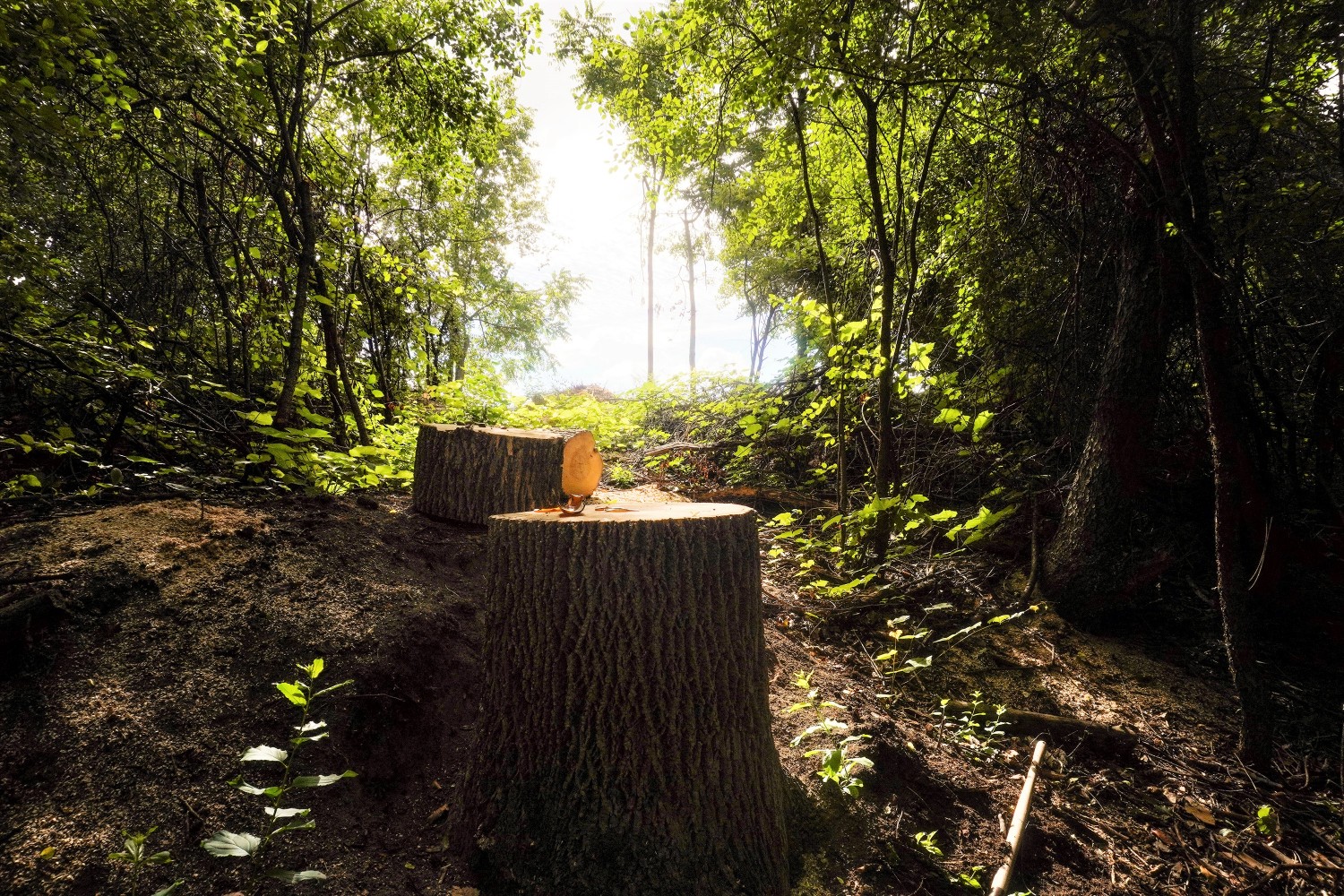
Part 2—Why wasn’t the public informed about the significance of Huttonville Forest, slated to be razed for development?
On October 26, 2020, Brampton’s Planning and Development Committee decided Huttonville Forest is not worth preserving.
Two days later the final nail in the coffin was hammered in, as City Council amended the Official Plan for the Riverview Heights subdivision, almost guaranteeing the forest’s destruction.
At the planning meeting, councillors agreed to the subdivision plan ‘on consent’ meaning no discussion or debate took place, as the matter was deemed uncontroversial. At the full Council meeting days later, where the committee decision was ratified, once again, no debate or discussion took place, no questions were asked.
Now, residents who feel like they were left in the dark during the decades-long planning process for the transformative development are asking who had a hand in dooming the Huttonville Forest.
The Huttonville North Residents Association (HNRA) has been advocating for the preservation of the ecologically significant greenspace. It sits on a cornfield between Embleton Road and Heritage Road, west of Mississauga Road. Nearby Huttonville Public School is the only building within proximity to the forest and according to locals, children have for decades enjoyed exploring its maze of natural features.


A full corn field still grows each year feeding animals nearby, despite the land being prepped to become a residential subdivision.
(Alexis Wright/The Pointer)
Riverview Heights is a part of the Brampton West Secondary Plan which encompasses 6,050 acres of land. It is one of Brampton’s last greenfield areas being turned into low/medium density residential developments with businesses, public institutions and natural features — Huttonville Forest not being one of them.
Ken MacDonald, chair of the HNRA, first discovered the forest removal after comparing a block plan to a Google Maps satellite image. A row of homes was proposed directly overtop the 2.6-hectare forest by Great Gulf Homes, which has assembled the land for development.
Since MacDonald discovered the plan, residents have tried to get council members and the developer to reconsider. The Pointer’s previous reporting on the forest found numerous endangered or threatened species living in the area, including the redside dace, the Eastern meadowlark and the butternut tree.
Saving the Huttonville Forest—Part 1
Within the forest, a Provincially Significant Wetland (PSW), and a locally significant ecological space that acts as a carbon sink, the developer must abide by terms of the PSW designation, but the local wetland significance does not demand the same protection. Instead, plans to fill the local wetland area are already in motion. Residents fear widespread destruction, including activity that will eventually threaten the provincial protections, is inevitable.
An Environmental Impact Study (EIS) completed in 2011 called the forest “highly disturbed” and, “considered to be low function with a low requirement for protection.” According to the EIS, portions of soil on the north end of the forest were disturbed when Highway 407 was built. Great Gulf hired SLR Consulting Canada Ltd. to look into all woodlots within the area.
In an email shared by MacDonald with The Pointer, the principal ecologist of SLR at the time said, “The treed feature in question is located below the top of bank to the west and clearly not a historical extension of the very important trees on the slope. It was found to be a mixture of thicket, meadow and open woodland.”
SLR, hired by the developer, found the forest is not ecologically beneficial and determined the locally significant wetland to be “isolated and of poor quality.”
This is not how the Credit Valley Conservation Authority (CVC) sees it.
The CVC monitors the area of Huttonville Forest and was involved in the development proposal from the beginning. The local residents’ group wants to know why, contrary to the company hired by the developer, an internal memo from a CVC ecologist/planner states Huttonville Forest should be preserved.
The HNRA filed a freedom of information request to obtain records from CVC.
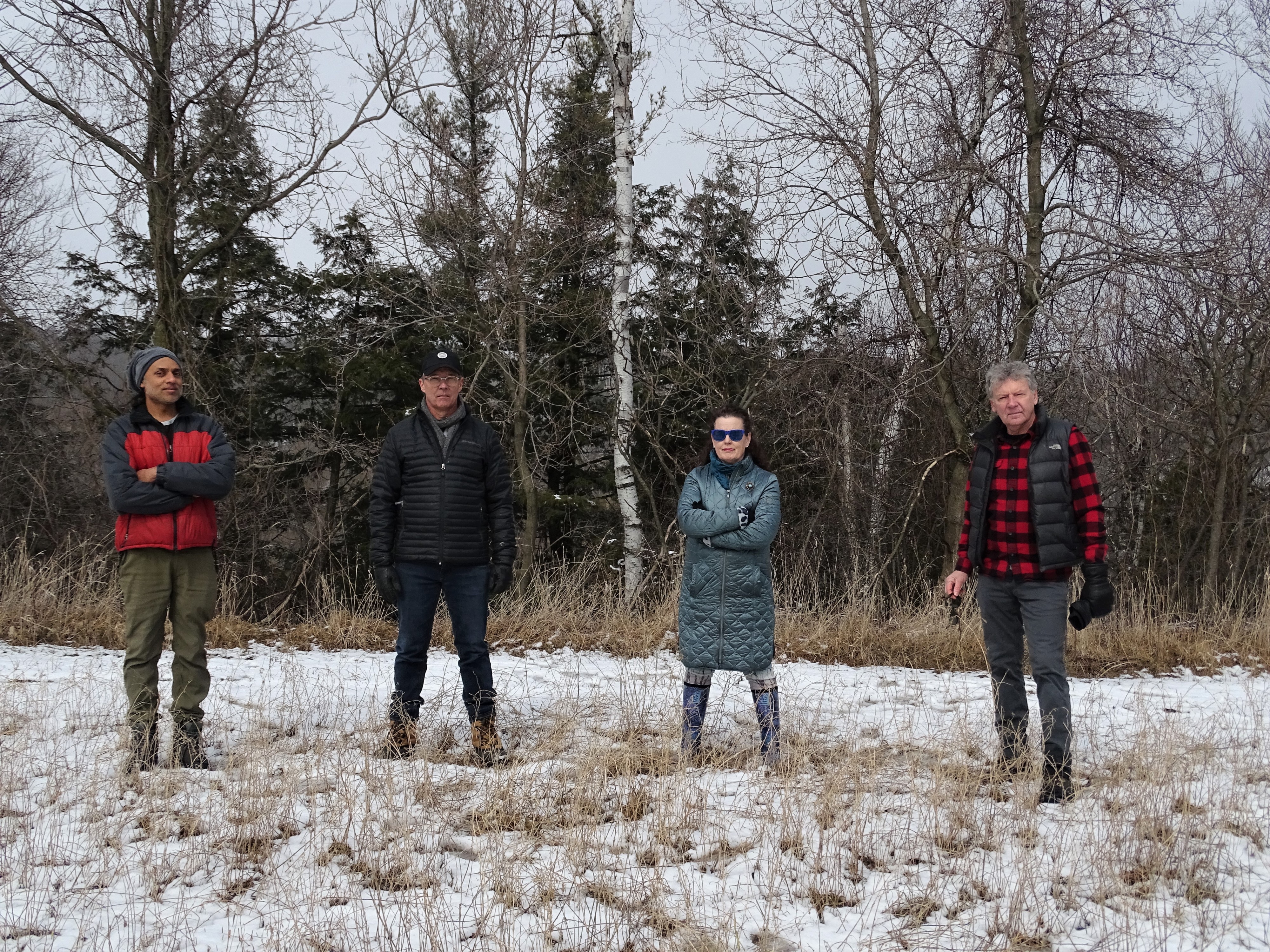
A small group of passionate residents are advocating for the preservation of Huttonville Forest. (Left) Tushar Mehta, Don Naylor, Julie Harlow and Ken MacDonald.
(Natasha O’Neill/The Pointer)
“We knew that there was, first of all, a secondary plan for that neighbourhood that included the retention of the forest. It was clearly delineated on the secondary Bram West Plan,” MacDonald says. “We were curious how that became released. We had been given certain information from the developer's application with the city but we wanted to learn more about what was the undertakings at the Conservation Authority, specifically.”
The group discovered that at least one key CVC staff member tried to save the Huttonville Forest.
On November 25, 2010 (about eight months before the EIS was finalized by SLR) CVC planner/ecologist, Adèle Labbé, wrote to CVC’s then acting senior manager of Planning and Development Service, Dorothy Di Berto, the forest should be considered a “significant woodland."
“[C]VC staff are of the opinion these units require consideration as part of the significant woodland and/or functional adjacent lands,” she wrote. “Based on the description provided in the [Environmental Impact Report], the plantation may not qualify as woodland due to the understory exhibiting invasive species only, with little complexity.
“This can be easily confirmed through a site visit with CVC staff. The Cultural Woodlands contiguous with the significant woodland in feature B …however appear to qualify as part of the significant woodland.”
The SLR report names multiple tree species that are not invasive including the Manitoba Maple, Trembling Aspen, Silver Maple, White Birch, White Pine, Red Pine and Balsam Poplar.
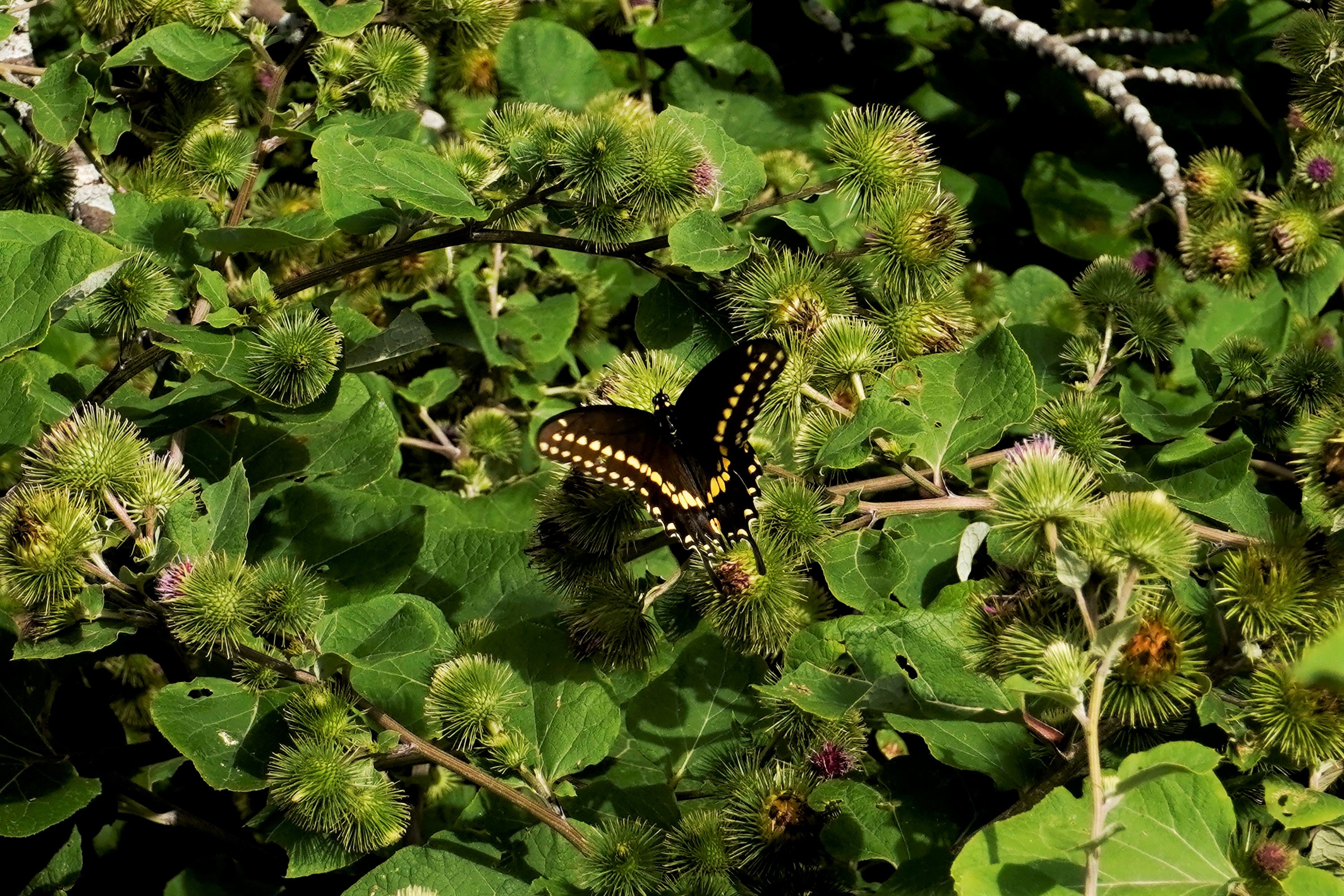
A Black Swallowtail butterfly seen in the area of Huttonville Forest will have to find a new home soon.
(Alexis Wright/The Pointer)
It is unclear how SLR consultants found the forest to be not worth preservation just eight months after Labbé flagged its importance.
The Pointer asked CVC to clarify the internal memo, asking about the process for how the authority makes its decisions and if more than one ecologist has to be in agreement.
“CVC staff review planning applications such as this, in the context of applicable provincial, municipal and CVC policies and guidelines,” a CVC spokesperson told The Pointer in an email. “Advice and input into the development proposals is provided to the municipality for their consideration in the approval process.”
Labbé continued to explain how there are endangered species residing in the area (the names are redacted in the FOI documents) and how one of the species is found in “at least two woodlands in the Block.”
The Endangered Species Act is enforced by the Ministry of Environment, Conservation and Parks. It is responsible for commenting on any concerns.
The Ministry did not provide a response ahead of publication.
Huttonville Forest is on the edge of the Credit River ravine which drops down to the rushing waterway below. The environmental reports have mentioned the need for a buffer between the future houses and the mature forest along the ravine slopes, which developers have agreed to build at a height of 10 metres. Labbé argues in her memo that Huttonville Forest, which is in close proximity to the valley trees, should be part of the preservation efforts, just like the buffering wall.
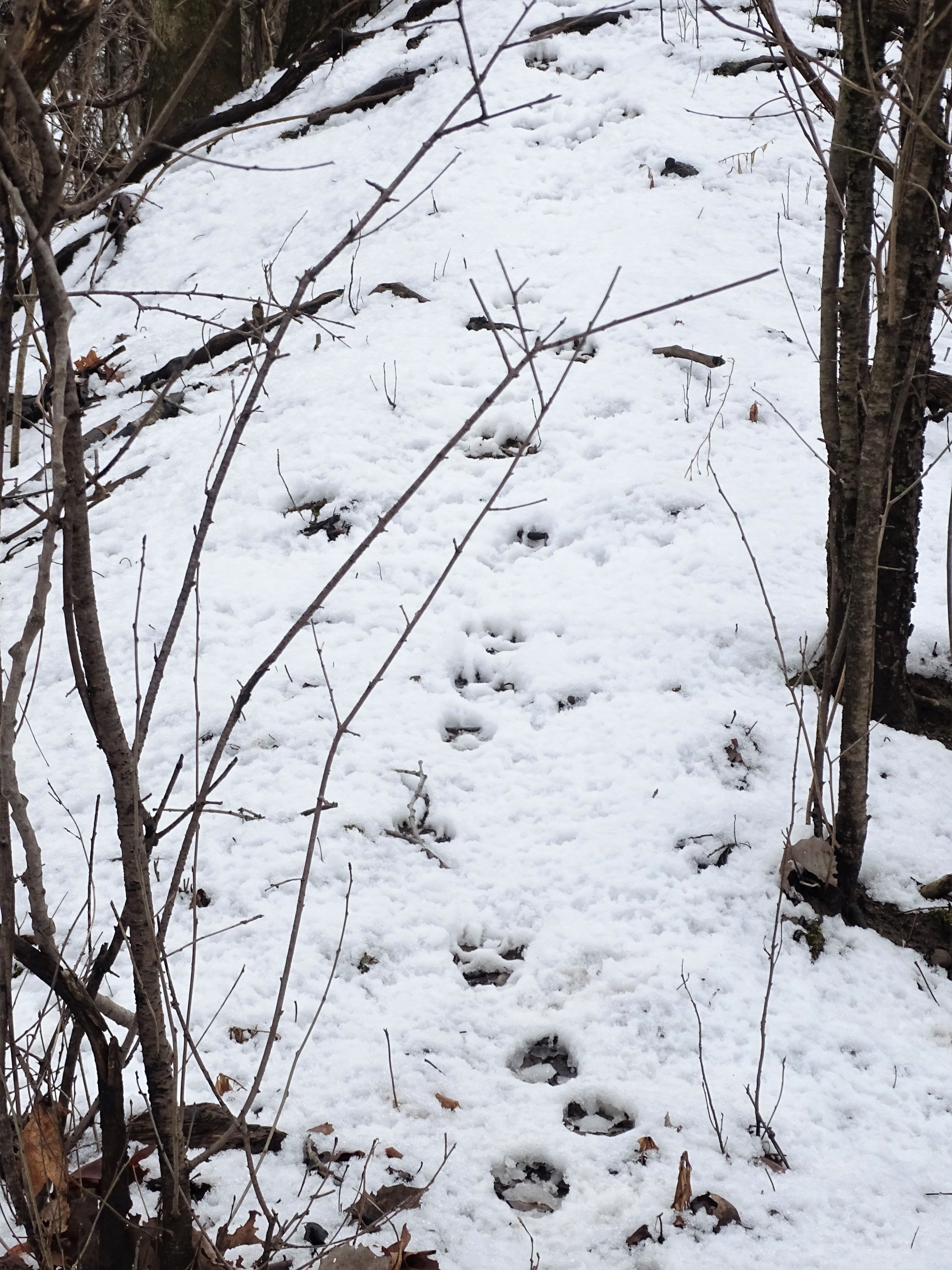
Tracks in the snow are common in Huttonville Forest, home to many animals that shelter in the dense forest.
(Natasha O’Neill/The Pointer)
The report from SLR explains Great Gulf plans to cover the area next to the PSW with “fill.” Huttonville Forest had been disturbed prior to Great Gulf owning the lot. Deep craters line large portions of the northern woodlot, where Mother Nature has since taken over the forest’s natural regrowth following damage related to earlier projects. Trees and other vegetation have grown back, but all of it is set to be clear cut.
In order for the developer to build homes, the forest must be razed and the land levelled.
Behind Huttonville Public School, the developers have planned a stormwater management pond.
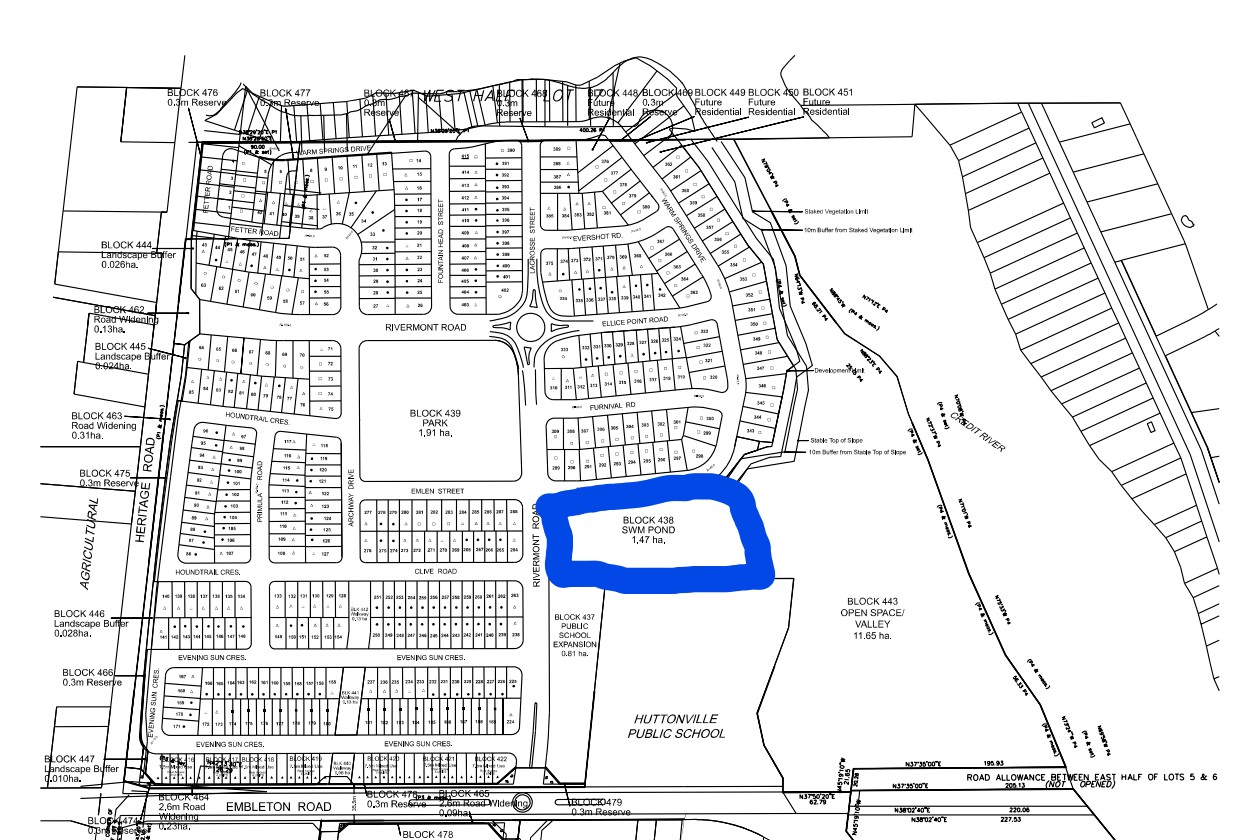
In other renditions of plans, a separate pond is pictured in the valley space below as the outfall area for the primary stormwater management pond.
(Great Gulf Homes)
“The proposed (stormwater pond) will result in both short-term and long-term negative impacts to the integrity of the Credit River Valley, which is a Core Area in the Regional Greenland system,” Labbé wrote in her memo.
According to her report, the developers have “concluded” this was the only area for the pond. Labbé advised that “offsetting the negative impacts” to the provincially protected area could be accomplished by preserving the Huttonville Forest since it is already a natural buffer.
Instead, developers decided to design the groundwater flow “around the pond to maintain water supply” for the Provincially Significant Wetland.
The buffer Labbé wanted would have been “situated to expand the naturalized area and buffer adjacent to the PSW.”
Instead, Great Gulf is destroying the Huttonville Forest, a thriving ecosystem that provides a buffer to a delicate wetland.
Great Gulf did not respond to questions.
The CVC asked Great Gulf to clarify plans for the stormwater pond and its efforts to accommodate locally rare or protected species.
Labbé was also concerned about another locally significant wetland on the land adjacent to Huttonville Forest, south of Embleton Road, which Great Gulf also owns. This wetland (called C3x) is part of the Levi Creek Subwatershed.
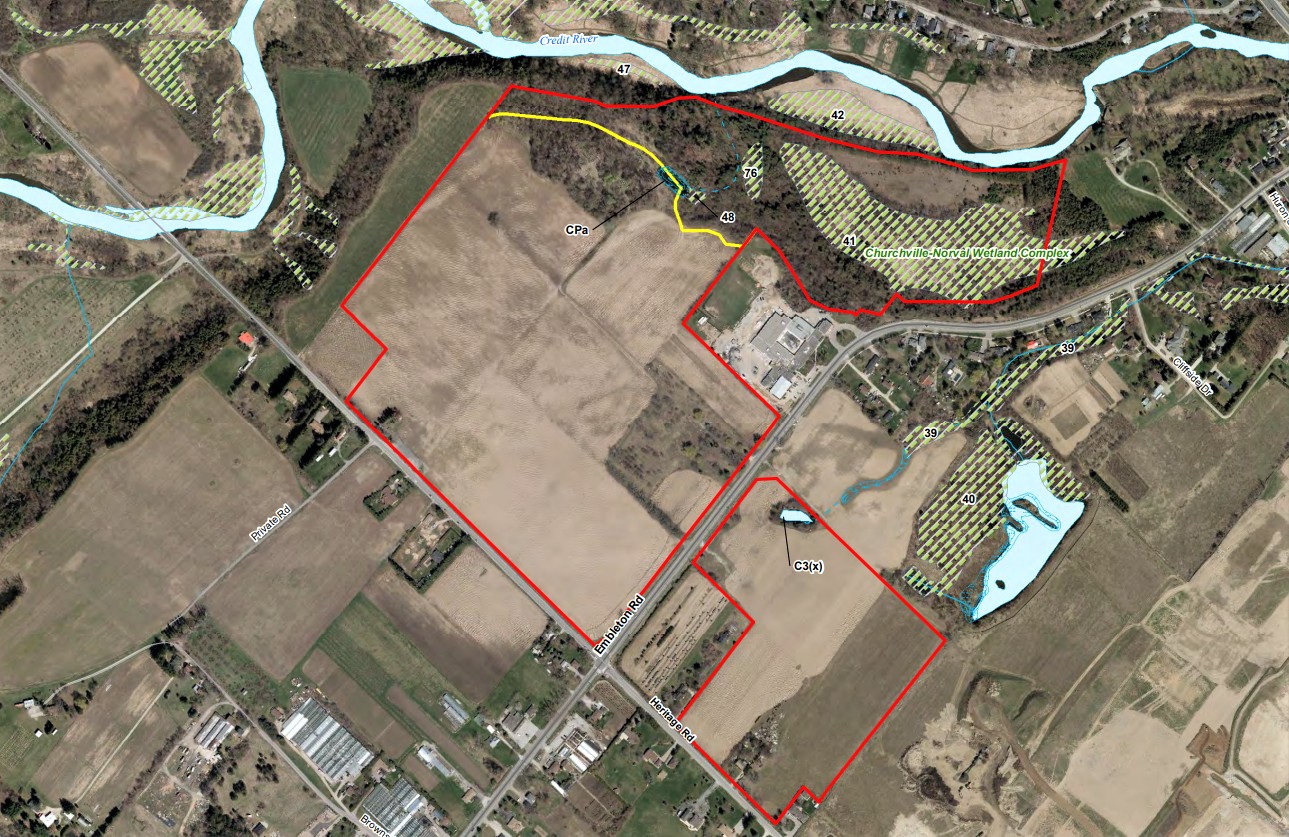
There are numerous Provincially Significant Wetlands in the area of the development, at least two have risks of being impacted by the construction according to a Credit Valley Conservation Authority ecologist.
(Great Gulf Homes)
“The conceptual compensation proposed for the removal of wetland C3(x) is not acceptable,” Labbé wrote.
Her protest fell on deaf ears as this portion of the development is now slated for low/medium-rise homes. The possible destruction of the creek which flows into the Credit River is not detailed in Labbé’s memo.
An email from project management company Malone Given Parsons Ltd., which was hired by Great Gulf, shows Di Berto of CVC was contacted shortly after the first environmental impact study was completed.
“I’m trying to collect all of the outstanding items required to obtain Stage 2 Block Plan approval for these lands,” Joan MacIntyre writes to Di Berto on July 11, 2011. “Rob Nykyforchyn needs sign-off from you to confirm the EIR [Environmental Impact Report] has been significantly advanced for the purposes of Stage 2 Approval.”
On July 18, Di Berto wrote back: “I can confirm that we are comfortable with agreeing that the EIR is significantly advanced to move forward with Stage 2 approval.”
This appears to contradict the warnings raised by Labbé, who had the specific expertise and experience to advise on the matter.
A conservation authority can only suggest areas of concern when a development proposal comes forward for approval, and holds little to no weight to force developers or municipalities against making decisions that could harm the natural features of an area.
Ultimately, the City decides. And if a developer does not like that decision, it can appeal through Ontario’s planning tribunal, which has historically sided with the building industry.
“As a commenting agency, in the municipal planning process, CVC coordinates our permitting requirements (for natural hazards) in accordance with Ontario Regulation 160/06, and also provides technical input on natural heritage and other non-natural hazard-related items as requested by the municipality or as identified through Memorandums of Understanding (MOU),” a spokesperson for CVC told The Pointer.
The Great Gulf development plan has been approved by Brampton Council. The City did not respond to questions.
“The applicant is working towards fulfilling the conditions of draft approval and CVC and the City of Brampton will continue to review the detailed design submissions, including any permitting requirements for grading/development within the CVC Regulated area,” a spokesperson for CVC said.
The concerned residents around Huttonville Forest believe there are gaps in the explanation for how and why the forest was slated to be destroyed. MacDonald says there is little the group can do now. The decision has been made, but the FOI documents, he says, reveal a lot about how the process was handled.
“We fought the good fight,” he says. “It's exhausting; it's tiring for citizens to have to do what seems to be obviously right.”
Huttonville Forest’s days are numbered. The once thriving and “significant” forest will be destroyed, once and for all.
The place where Brampton children have played for decades, where species have found protection from human encroachment, and where the delicate balance of the local ecosystem has been maintained through periods of disruption, will soon be no more.
“The bodies that we think are protecting nature aren't necessarily doing so,” MacDonald says. That function is “not necessarily there. Although it may appear to be and it’s in their goals and vision and mandate, it is not necessarily the way things are working.”
Email: [email protected]
Twitter: @taasha__15
COVID-19 is impacting all Canadians. At a time when vital public information is needed by everyone, The Pointer has taken down our paywall on all stories relating to the pandemic and those of public interest to ensure every resident of Brampton and Mississauga has access to the facts. For those who are able, we encourage you to consider a subscription. This will help us report on important public interest issues the community needs to know about now more than ever. You can register for a 30-day free trial HERE. Thereafter, The Pointer will charge $10 a month and you can cancel any time right on the website. Thank you
Submit a correction about this story


